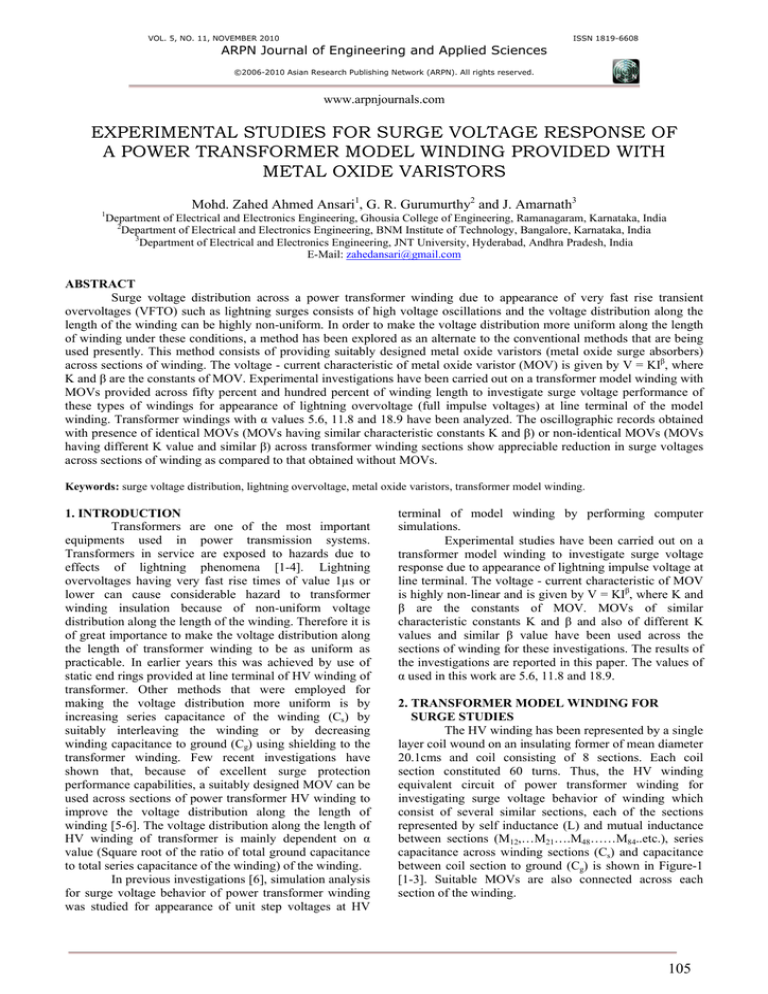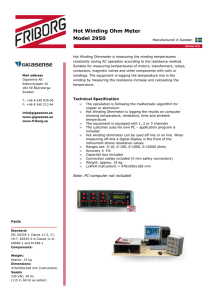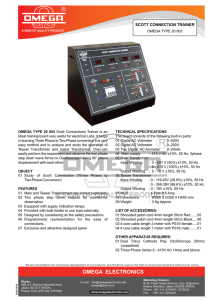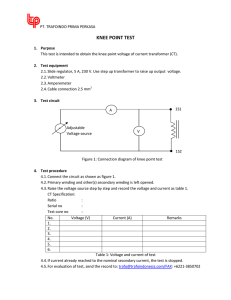
VOL. 5, NO. 11, NOVEMBER 2010
ISSN 1819-6608
ARPN Journal of Engineering and Applied Sciences
©2006-2010 Asian Research Publishing Network (ARPN). All rights reserved.
www.arpnjournals.com
EXPERIMENTAL STUDIES FOR SURGE VOLTAGE RESPONSE OF
A POWER TRANSFORMER MODEL WINDING PROVIDED WITH
METAL OXIDE VARISTORS
Mohd. Zahed Ahmed Ansari1, G. R. Gurumurthy2 and J. Amarnath3
1
Department of Electrical and Electronics Engineering, Ghousia College of Engineering, Ramanagaram, Karnataka, India
2
Department of Electrical and Electronics Engineering, BNM Institute of Technology, Bangalore, Karnataka, India
3
Department of Electrical and Electronics Engineering, JNT University, Hyderabad, Andhra Pradesh, India
E-Mail: zahedansari@gmail.com
ABSTRACT
Surge voltage distribution across a power transformer winding due to appearance of very fast rise transient
overvoltages (VFTO) such as lightning surges consists of high voltage oscillations and the voltage distribution along the
length of the winding can be highly non-uniform. In order to make the voltage distribution more uniform along the length
of winding under these conditions, a method has been explored as an alternate to the conventional methods that are being
used presently. This method consists of providing suitably designed metal oxide varistors (metal oxide surge absorbers)
across sections of winding. The voltage - current characteristic of metal oxide varistor (MOV) is given by V = KIβ, where
K and β are the constants of MOV. Experimental investigations have been carried out on a transformer model winding with
MOVs provided across fifty percent and hundred percent of winding length to investigate surge voltage performance of
these types of windings for appearance of lightning overvoltage (full impulse voltages) at line terminal of the model
winding. Transformer windings with α values 5.6, 11.8 and 18.9 have been analyzed. The oscillographic records obtained
with presence of identical MOVs (MOVs having similar characteristic constants K and β) or non-identical MOVs (MOVs
having different K value and similar β) across transformer winding sections show appreciable reduction in surge voltages
across sections of winding as compared to that obtained without MOVs.
Keywords: surge voltage distribution, lightning overvoltage, metal oxide varistors, transformer model winding.
1. INTRODUCTION
Transformers are one of the most important
equipments used in power transmission systems.
Transformers in service are exposed to hazards due to
effects of lightning phenomena [1-4]. Lightning
overvoltages having very fast rise times of value 1µs or
lower can cause considerable hazard to transformer
winding insulation because of non-uniform voltage
distribution along the length of the winding. Therefore it is
of great importance to make the voltage distribution along
the length of transformer winding to be as uniform as
practicable. In earlier years this was achieved by use of
static end rings provided at line terminal of HV winding of
transformer. Other methods that were employed for
making the voltage distribution more uniform is by
increasing series capacitance of the winding (Cs) by
suitably interleaving the winding or by decreasing
winding capacitance to ground (Cg) using shielding to the
transformer winding. Few recent investigations have
shown that, because of excellent surge protection
performance capabilities, a suitably designed MOV can be
used across sections of power transformer HV winding to
improve the voltage distribution along the length of
winding [5-6]. The voltage distribution along the length of
HV winding of transformer is mainly dependent on α
value (Square root of the ratio of total ground capacitance
to total series capacitance of the winding) of the winding.
In previous investigations [6], simulation analysis
for surge voltage behavior of power transformer winding
was studied for appearance of unit step voltages at HV
terminal of model winding by performing computer
simulations.
Experimental studies have been carried out on a
transformer model winding to investigate surge voltage
response due to appearance of lightning impulse voltage at
line terminal. The voltage - current characteristic of MOV
is highly non-linear and is given by V = KIβ, where K and
β are the constants of MOV. MOVs of similar
characteristic constants K and β and also of different K
values and similar β value have been used across the
sections of winding for these investigations. The results of
the investigations are reported in this paper. The values of
α used in this work are 5.6, 11.8 and 18.9.
2. TRANSFORMER MODEL WINDING FOR
SURGE STUDIES
The HV winding has been represented by a single
layer coil wound on an insulating former of mean diameter
20.1cms and coil consisting of 8 sections. Each coil
section constituted 60 turns. Thus, the HV winding
equivalent circuit of power transformer winding for
investigating surge voltage behavior of winding which
consist of several similar sections, each of the sections
represented by self inductance (L) and mutual inductance
between sections (M12,…M21….M48……M84..etc.), series
capacitance across winding sections (Cs) and capacitance
between coil section to ground (Cg) is shown in Figure-1
[1-3]. Suitable MOVs are also connected across each
section of the winding.
105
VOL. 5, NO. 11, NOVEMBER 2010
ISSN 1819-6608
ARPN Journal of Engineering and Applied Sciences
©2006-2010 Asian Research Publishing Network (ARPN). All rights reserved.
www.arpnjournals.com
functioning in the nonlinear region (V = KIβ) so that the
surge voltage distribution along length of the winding is
improved.
Figure-1. Equivalent circuit representation of transformer
HV winding including mutual inductances for impulse
voltages with MOVs across all sections.
3. EXPERIMENTAL DETERMINATION OF
CHARACTERISTIC CONSTANTS K AND β OF
MOV
The circuit shown in Figure-2 has been used for
determination of constants of MOV (surge absorber
blocks), K and β. The capacitor bank Cb was charged to a
known voltage and voltage at points p and q with respect
to ground were recorded using the Digital storage
oscilloscope (Agilent make DSO 5034A, 300MHz,
2GaS/s, 4-Channel). Different varistors of voltage ratings
of 40, 50, 60, and 95 volts were selected for purposes of
experimental investigations. These low voltage varistors
have been selected from consideration which require that
the maximum voltage across the model winding should
not be higher than 2000V and it is desirable that the
maximum value of input voltage at line terminal is much
below this maximum voltage. Also, the varistors should be
Figure-2. Circuit diagram for measurement of
MOV constants.
Depending upon the voltage rating of the varistor,
two values of charging voltages for capacitor bank Cb
were selected. The capacitor bank was charged to any of
these voltages and voltage to ground at point p and q were
recorded (Figure-2). Few of these recorded oscillogaphs
are shown in Figures 3 and 4.
Sufficient numbers of samples were tested so that
values of β in the range 0.04 to 0.06 could be used for the
experimental investigations on the model winding. Some
of the representative experimental results obtained are
shown in Table-A1 of Appendix 1.
Figure-3. Varistor voltages at point’s p, q and ground, respectively for MOV rating of 95v.
106
VOL. 5, NO. 11, NOVEMBER 2010
ISSN 1819-6608
ARPN Journal of Engineering and Applied Sciences
©2006-2010 Asian Research Publishing Network (ARPN). All rights reserved.
www.arpnjournals.com
Figure-4. Varistor voltages at point’s p, q and ground, respectively for MOV rating of 40v.
(Vpg – Yellow, Vqg – Green, VMOV – Purple).
4. EXPERIMENTAL SETUP
A surge generator consisting of a capacitor bank
of total capacitance 0.2µF along with a spark gap and
waveshaping components were built for purposes of
carrying out experimental investigations on the model
winding. The best waveshape that could be obtained
across the line terminal and ground of the transformer
model winding was a front time of 1.4 µs (± 30%
tolerance) and a tail time of 50µs (±20% tolerance).
Several alterations of above circuit were tried including
connection of a low value capacitance (of order of 1000pf)
at line terminal to ground. These introduced peak
oscillations of magnitude ±15% (approximately). The
circuit used for achieving this waveshape after several
trials with the components is shown in Figure-5 along with
transformer model winding.
c)
d)
e)
f)
Low voltage impulse generator
Digital storage oscilloscope
Auto transformer (0-270V)
Step up transformer (220V - 7.5kV)
Figure-6. Experimental setup used for investigations of
surge voltage response with MOV.
5. RESULTS AND DISCUSSIONS
Figure-5. Schematic diagram for surge voltage
measurement with MOVs connected across sections
of transformer model winding (Figure-2).
A photograph of the experimental setup used for
investigations of surge voltage distribution with MOVs
provided across sections of winding is shown in Figure-6.
The apparatus used in this setup are listed below:
a) Transformer model winding
b) MOV connected across the winding section
5.1 Surge voltage response of transformer model
winding for lightning impulse voltage without
MOV
The surge generator output is connected to the
line terminal of the model winding (Figure-5). The
winding under experimental investigation is neutral
grounded type. The ground terminal of model winding is
connected to surge generator ground.
The voltages at different terminals along the
length of model winding with respect to time for values of
α equal to 5.6, 11.8 and 18.9 for a standard lightning
impulse voltage of front time 1.4µs (±30% tolerance) and
tail time of 50µs (±20% tolerance) applied at the line
terminal of equivalent circuit of transformer model
winding without MOV are recorded. The representative
oscillographic record of the surge voltages at different
107
VOL. 5, NO. 11, NOVEMBER 2010
ISSN 1819-6608
ARPN Journal of Engineering and Applied Sciences
©2006-2010 Asian Research Publishing Network (ARPN). All rights reserved.
www.arpnjournals.com
nodes to ground with respect to time and without MOVs
are shown in Figures 7 to 9 for the α value 11.8.
Figure-7. Per unit surge voltages at different nodes to ground 1, 2, 3 and 4
with respect to time without MOV (α = 11.8)
Figure-8. Per unit surge voltages at different nodes to ground 1, 5, 6 and 7
with respect to time without MOV (α = 11.8).
Figure-9. Per unit surge voltages at different nodes to ground 1, 7, 8 and 9
with respect to time without MOV (α = 11.8).
108
VOL. 5, NO. 11, NOVEMBER 2010
ISSN 1819-6608
ARPN Journal of Engineering and Applied Sciences
©2006-2010 Asian Research Publishing Network (ARPN). All rights reserved.
www.arpnjournals.com
5.2 Surge voltage response of transformer model
winding for lightning impulse voltage with MOV
across 50% of winding length
When MOVs of similar characteristic constants
K and β (K = 105 and average value of β = 0.055) are
connected across 50% of winding length, the surge voltage
response for an impulse voltage input at line terminal
gives oscillation only at those nodes of the winding where
MOVs are not connected. The oscillographic record
obtained in this case are shown in the Figures 10 to 12 for
α = 11.8.
Figure-10. Per unit surge voltages with MOV provided across
50% of the winding length at nodes 1, 2, 3 and 4
to ground with respect to time (α = 11.8).
Figure-11. Per unit surge voltages with MOV provided across
50% of the winding length at nodes 1, 5, 6 and 7
to ground with respect to time (α = 11.8).
109
VOL. 5, NO. 11, NOVEMBER 2010
ISSN 1819-6608
ARPN Journal of Engineering and Applied Sciences
©2006-2010 Asian Research Publishing Network (ARPN). All rights reserved.
www.arpnjournals.com
Figure-12. Per unit surge voltages with MOV provided across 50%
of the winding length at nodes 1, 6, 7 and 8 to ground
with respect to time (α = 11.8).
The maximum stresses in this case occur across
section between nodes 5-7 and 8-9 and these are
respectively 27% and 31.76%. However, the voltages
across sections provided with MOVs are considerably less
and the maximum value is less than 12%.
5.3 Surge voltage response of transformer model
winding for lightning impulse voltage with MOV
across 100% of winding length
The surge voltage distribution across sections of
winding when all the sections are provided with MOVs of
similar characteristics constants K and β (Average K = 105
and average β = 0.055) for α values 5.6, 11.8 and 18.9
were recorded. The representative oscillographic
recordings for α value 11.8 are shown in Figures 13 to 15.
We observe from these figures that there are no
oscillations on waveform of voltage to ground at different
node positions of the winding. The maximum value of
surge voltages across any section of the winding in this
case has reduced to 19.4%, 16.6% and 17.1% for α values
5.6, 11.8 and 18.9, respectively.
Figure-13. Per unit surge voltages with MOV provided across 100% of winding
length at nodes 1, 2, 3 and 4 to ground with respect to time (α = 11.8).
110
VOL. 5, NO. 11, NOVEMBER 2010
ISSN 1819-6608
ARPN Journal of Engineering and Applied Sciences
©2006-2010 Asian Research Publishing Network (ARPN). All rights reserved.
www.arpnjournals.com
Figure-14. Per unit surge voltages with MOV provided across 100% of winding
length at nodes 1, 5, 6 and 7 to ground with respect to time (α = 11.8).
Figure-15. Per unit surge voltages with MOV provided across 100% of winding
length at nodes 1, 6, 7 and 8 to ground with respect to time (α = 11.8).
A comparative analysis of the magnitude of
maximum voltages appearing across sections of the model
winding without and with MOVs of similar characteristics
connected across all the sections of winding are plotted in
Figures 16 to 18 for the three α values.
111
VOL. 5, NO. 11, NOVEMBER 2010
ISSN 1819-6608
ARPN Journal of Engineering and Applied Sciences
©2006-2010 Asian Research Publishing Network (ARPN). All rights reserved.
www.arpnjournals.com
Figure-16. Maximum voltages across sections of winding without and with identical
MOVs indicated between the corresponding nodes of the transformer model
winding (α = 5.6) (L) = Line end. (N) = Neutral end. *Time Instant at
which maximum voltage appear between the nodes.
Figure-17. Maximum voltages across sections of winding without and with identical
MOVs indicated between the corresponding nodes of the transformer
model winding (α = 11.8).
In these Figures, the maximum voltage appearing
across section between terminals of winding is indicated at
the middle point between terminals along with the time
instant of occurrence of maximum voltage stresses.
Similar experimental investigations were
performed by connecting MOVs of different K values like
175.9, 175.9, 130.6, 130.6, 103.3, 103.3, 95.6 and 95.6
across sections 1-2, … 7-8 respectively. The average value
of β used is 0.055. The representative oscillographic
recordings for α value 18.9 are shown in Figures 19 to 21.
We observe from these figures that there are no
oscillations on waveform of voltage to ground at different
node positions of the winding. The maximum value of
surge voltages across any section of the winding in this
case has reduced to 19.3%, 19.3% and 15.8% for α values
5.6, 11.8 and 18.9, respectively.
112
VOL. 5, NO. 11, NOVEMBER 2010
ISSN 1819-6608
ARPN Journal of Engineering and Applied Sciences
©2006-2010 Asian Research Publishing Network (ARPN). All rights reserved.
www.arpnjournals.com
Figure-19. Per unit surge voltages with Non-Identical MOV provided across
100% of the winding length at different nodes 1, 2, 3 and 4 to ground
with respect to time (α = 18.9).
Figure-20. Per unit surge voltages with Non-Identical MOV provided across
100% of the winding length at different nodes 1, 5, 6 and 7 to ground
with respect to time (α = 18.9).
113
VOL. 5, NO. 11, NOVEMBER 2010
ISSN 1819-6608
ARPN Journal of Engineering and Applied Sciences
©2006-2010 Asian Research Publishing Network (ARPN). All rights reserved.
www.arpnjournals.com
Figure-21. Per unit surge voltages with Non-Identical MOV provided across
100% of the winding length at different nodes 1, 6, 7 and 8 to ground
with respect to time (α = 18.9).
A comparison of voltage stresses across
transformer model winding sections without and with
MOVs of dissimilar characteristic constants (Different K
and Similar β) for α values 5.6, 11.8 and 18.9 are
respectively shown in Figures 22 to 24 for lightning
impulse voltage.
It can be observed from Figures 16 to 18 and
Figures 22 to 24 that voltage stresses across sections of
transformer winding have been considerably reduced by
providing MOV blocks across all the sections of
transformer model winding irrespective of whether
identical or non- identical MOVs are connected across the
sections of winding. However, for non-identical MOVs
provided across sections some of the sections can be
affected with increased voltage stress as compared to that
obtained with identical MOVs.
Figure-22. Maximum voltages across sections of winding without and with
non-identical MOVs indicated between the corresponding nodes of the
transformer model winding (α = 5.6).
114
VOL. 5, NO. 11, NOVEMBER 2010
ISSN 1819-6608
ARPN Journal of Engineering and Applied Sciences
©2006-2010 Asian Research Publishing Network (ARPN). All rights reserved.
www.arpnjournals.com
Figure-23. Maximum voltages across sections of winding without and with
Non-Identical MOVs indicated between the corresponding nodes of the
transformer model winding (α = 11.8).
Figure-24. maximum voltages across sections of winding without and with
non-identical MOVs indicated between the corresponding nodes
of the transformer model winding (α = 18.9).
6. CONCLUSIONS
The Experimental investigations carried out on a
transformer model winding for α values 5.6, 11.8 and 18.9
and for appearance of lightning impulse voltage at the line
terminal of model winding have given rise to the following
conclusions:
a) The surge voltage response of a transformer model
winding without MOVs across sections of winding
consists of voltage oscillations of natural frequencies.
b) By providing MOVs of similar characteristic constants
K and β across 50% of winding length, the surge
voltage stresses are reduced to a considerable extent
115
VOL. 5, NO. 11, NOVEMBER 2010
ISSN 1819-6608
ARPN Journal of Engineering and Applied Sciences
©2006-2010 Asian Research Publishing Network (ARPN). All rights reserved.
www.arpnjournals.com
across those sections where MOVs are provided. The
oscillations in voltage waveform appear only at nodes
to which MOV terminals are not connected.
c) By providing MOVs of similar characteristic constants
across 100% of winding length, surge voltage stresses
across the sections of winding are considerably
reduced and there are no oscillations in the voltage
waveform at any of the nodes.
d) In case where MOVs of dissimilar characteristic
constants (i.e., different K and similar β values) are
provided across all the sections of winding, there is a
reduction in surge voltage stresses across sections of
winding and no oscillations appear in voltage
waveform.
e) By providing suitable MOVs across sections of model
winding, the maximum value of voltage to ground at
any of the nodes does not exceed the peak value of the
input impulse voltage at line terminal.
ACKNOWLEDGMENTS
The author Mohd. Z. A. Ansari would like to
thank the authorities of Ghousia College of Engineering,
Ramanagaram and JNTU, Hyderabad, the author G. R
Gurumurthy would like to thank authorities of BNM
Institute of Technology, Bangalore, for all the cooperation
and encouragement.
REFERENCES
[2] S. B Vasutinsky. 1962. Principles, operation and
design of power transformer. PSG College of
Technology, Coimbatore, Tamilnadu, India.
[3] B. Heller and A. Veverka. 1968. Surge phenomena in
electrical machine. Iliffe Books Ltd, London.
[4] E. Kuffel, W. S. Zaengl and J. Kuffel. 2000. High
voltage
engineering
fundamentals.
Newnes
(Butterworth- Heinemann).
[5] Wen Yuanfang and Chengke Zhou. 2005.
Experimental studies on the use of MOV in
transformer windings inner protection. IEEE Trans. on
power delivery. 20(2): 1441-1446.
[6] Yuanfang Wen and Chengke Zhou. 2004. A novel
method for predicting the life time of MOV. IEEE
Trans. Power Delivery. 19(4): 1688-1691.
[7] Mohd. Z. A. Ansari, G. R. Gurumurthy, J. Amarnath
and N. K. Kishore. 2006. Surge Voltage Stresses
Across Power Transformer Winding Sections
Provided With Metal Oxide Surge Absorber Blocks.
Proceedings of IEEE International Conference on
Electrical Insulation and Dielectric Phenomena
(CEIDP-2006). 16th -19th October. Held at Kansas
City, Missouri, USA. pp. 229-232.
[1] L. F. Blume, Boyajian G. Camith, T.C Lennox, S.
Minneci, V.M Montsinger. 1952. Transformer
Engineering. John Wiley and Sons.
Appendix 1
Table-A1. Experimental data for determination of K and β of MOV.
#
Varistor
rating
(volts)
1
95
2
60
3
50
4
40
Capacitor bank
charging
voltage (volts)
200
250
150
190
120
160
100
140
Measured
values (volts)
Vp
Vq
185
225
142.5
175.0
112.5
142.5
100
130
7
32
9
34
7
27
4.7
26
VMOV
(Vp-Vq)
178
193
133.5
141
105.5
115.5
95.3
104
Current
through
MOV (amps)
I1
1.4
1.8
1.4
0.94
-
I2
6.4
6.8
5.4
5.2
β
K
0.05
175.9
0.04
130.6
0.06
103.3
0.05
95.6
116




